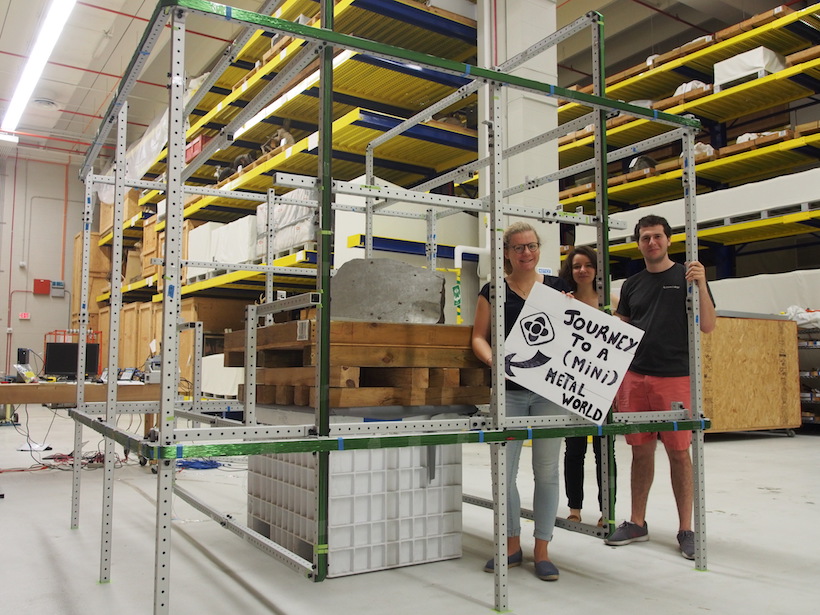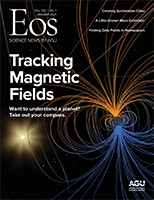For a week in the summer of 2019, a Smithsonian Institution warehouse looked like a scene from a 1950s science fiction story: a 2-meter prism of magnetic coils arranged around a half-meter-long meteorite.
For researchers Elise Clavé and Clara Maurel, this was the payoff of four hectic months building and testing a brand-new portable magnetometer. The new tool was built to measure the magnetic moment of five meteorites up to 1.2 meters in size using a 100-kilogram apparatus. Their results were published in October in Geochemistry, Geophysics, Geosystems.
Julie Hoskin, collection manager of meteorites at the Smithsonian’s National Museum of Natural History in Washington, D.C., says her collections team has moved everything from priceless art to giant fossils, but maneuvering so many big rocks was an exciting challenge. Clavé and Maurel “ended up looking at some of the largest meteorites we have,” she said, adding that the most common request from scientists is to look at very thin slices of meteorites.
Maurel, currently a Ph.D. candidate in planetary sciences at the Massachusetts Institute of Technology, said the magnetic moment—the signature of the strength and orientation of an object’s magnetic field—had previously been measured in metallic meteorites less than 10 centimeters in size but never in such massive objects.
Maurel is a member of the magnetic investigations group for the uncrewed NASA mission to Psyche, a dense and metal-rich asteroid about 200 kilometers in diameter located in the asteroid belt between Mars and Jupiter.
Clavé, who provided the instrument-building know-how for the Earth-based magnetometer and is now a Ph.D. student on NASA’s Mars2020 SuperCam team, explained that Psyche is the suspected remnant core of a larger planetary body. A range of magnetic measurements from Earth’s biggest meteorites may help predict what magnetic signatures might be found there.
“One big challenge was to get rid of the Earth’s magnetic field and only measure the magnetic field generated by the meteorite itself in order to recover its magnetic moment,” Clavé said, adding this was achieved through careful instrument design and sensor calibration.
Magnetic Mysteries
Jerôme Gattacceca, a paleomagnetist and meteoricist at France’s European Centre for Research and Teaching in Environmental Geoscience, said magnetic fields on planets like Earth are generated when, deep inside the planet, moving molten iron driven by convection currents creates a magnetic field.
The magnetic field leaves its signature in rocks, even long after the core has cooled and the magnetic field is gone, which has already happened on the Moon and Mars.
Gattacceca said that once a rock drops below its Curie point (between 500°C and 700°C for the most common magnetic minerals), the magnetic signature won’t change significantly until exposed to another strong magnetic field or major geologic event. Another strong magnetic field might come from a handheld magnet, he said, and many small meteorites have had billions of years of magnetic information wiped when meteorite hunters put hand magnets on them.
“The rock is like a magnetic tape, it can retain a magnetic memory,” Gattacceca said. “If there is lava coming out today, it will have the magnetic memory of that day.”
Gattacceca said a rock’s “memory” can provide valuable insights into the earliest history of the solar system—and the functioning of our own planet.
“Magnetism is the only method to allow access to the deep structures of planetary bodies so far back in time.”
“Magnetism is the only method to allow access to the deep structures of planetary bodies so far back in time,” he said. “You can look at the intensity and age of the field, including when it stopped.”
Benjamin Weiss, a professor of planetary sciences at the Massachusetts Institute of Technology, a coinvestigator on NASA’s Psyche mission, and Maurel’s Ph.D. supervisor, said NASA’s Psyche mission is hoping to find evidence of whether small bodies like asteroids, only a few hundred kilometers in diameter or smaller, once generated magnetic fields like planets do today.
“By measuring bigger meteorite pieces on Earth, you provide more certainty that the signal is coming from an ancient source, not from any contamination,” Weiss said.
The Psyche mission won’t arrive at the asteroid until 2026 and will have only one shot to gather magnetic data, so Weiss said it’s important to get as many meteorite magnetic data points as possible before then.
He said of the known meteorite parent bodies on Earth, about 70%–80% come from iron asteroids and there are about a dozen known meteorites more than a meter in diameter. These could potentially be measured by the new magnetometer.
“Our dream would be to take this thing on a global road trip and hit all the big ones!” he said.
—Andrew J. Wight (@ligaze) Science Writer
Citation:
Wight, A. J. (2020), Measuring massive magnetic meteorites, Eos, 101, https://doi.org/10.1029/2020EO151292. Published on 04 November 2020.
Text © 2020. The authors. CC BY-NC-ND 3.0
Except where otherwise noted, images are subject to copyright. Any reuse without express permission from the copyright owner is prohibited.


